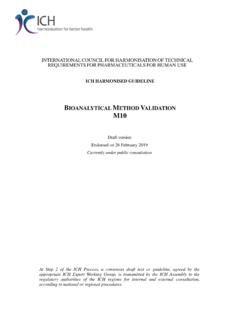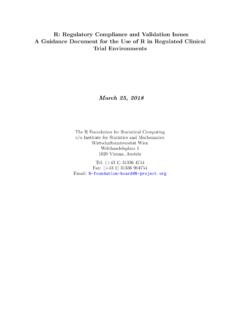Transcription of Guideline Bioanalytical method validation
1 Superseded30 Churchill Place Canary Wharf London E14 5EU United Kingdom An agency of the European Union Telephone +44 (0)20 3660 6000 Facsimile +44 (0)20 3660 5555 Send a question via our website European Medicines Agency, 2015. Reproduction is authorised provided the source is acknowledged. 21 July 2011 EMEA/CHMP/EWP/192217/2009 Rev. 1 Corr. 2** Committee for Medicinal Products for Human Use (CHMP) Guideline on Bioanalytical method validation Draft agreed by the Efficacy Working Party September 2009 Adoption by CHMP for release for consultation 19 November 2009 End of consultation (deadline for comments) 31 May 2010 Agreed by Pharmacokinetics Working Party (PKWP) June 2011 Adoption byCHMP21 July 2011 Date for coming into effect 1 February 2012 *The corrections concern: Section Accuracy (p.)
2 7), paragraph Within-run accuracy: concentration level ofMQC; Section 6 Incurred samples reanalysis (p. 13), paragraph 2: inclusion of the equation; Section Stability of the samples (p. 16), paragraph 1: deletion of the last sentence A bracketing approach may beconsidered. ; typographical correction in the title of Section Acceptance criteria for study sample analysis ( ).*The corrections concern: Section reference standards (p. 5), paragraph 2 and 3: eliminated reference tocertified CHMP, EMEA, Guideline , validation , Bioanalytical method , analyses This Guideline is superseded by the ICH Guideline M10 on Bioanalytical method validation and study sample analysis, following its finalisation in July 2022 SupersededGuideline on Bioanalytical method validation EMEA/CHMP/EWP/192217/2009 Rev.
3 1 Corr. 2** Page 2/23 Guideline on Bioanalytical method validation Table of contents 1. Introduction (background) .. 3 33. Legal basis .. 3 4. method validation .. 4 Full validation of an analytical Selectivity .. 5 Carry-over .. 6 Lower limit of Calibration curve .. 6 Accuracy .. 7 Dilution integrity .. 8 Matrix effect .. 8 Partial validation .. 10 Cross validation .. 10 5. Analysis of study samples .. 11 Analytical 11 Acceptance criteria of an analytical Calibration range .. 12 Reanalysis of study samples .. 12 Incurred samples reanalysis .. 13 7. Ligand binding Full validation .. 15 Partial validation and cross- validation .. 18 Analysis of study samples.
4 18 Analytical Acceptance criteria for study sample analysis .. 18 Incurred samples reanalysis .. 18 .. validation report .. 18 Analytical report .. 19 Definitions .. 21 SupersededGuideline on Bioanalytical method validation EMEA/CHMP/EWP/192217/2009 Rev. 1 Corr. 2** Page 3/23 Executive summary This Guideline defines key elements necessary for the validation of Bioanalytical methods . The Guideline focuses on the validation of the Bioanalytical methods generating quantitative concentration data used for pharmacokinetic and toxicokinetic parameter determinations. Guidance and criteria are given on the application of these validated methods in the routine analysis of study samples from animal and human studies.
5 (background)Measurement of drug concentrations in biological matrices (such as serum, plasma, blood, urine, andsaliva) is an important aspect of medicinal product development. Such data may be required tosupport applications for new actives substances and genericsas well as variations to authorised drugproducts. The results of animal toxicokineticstudies andof clinical trials, including bioequivalence studies are used to make critical decisions supporting the safety and efficacy of a medicinal drugsubstance or product. It is therefore paramount that the applied Bioanalytical methods used are well characterised, fully validated and documented to a satisfactory standard in order to yield criteria wider than those defined in this Guideline may be used in special situations.
6 Thisshould be prospectivelydefined based on the intended use of the Guideline provides recommendations for the validation of Bioanalytical methods applied to measure drug concentrations in biological matrices obtained in animal toxicokineticstudiesandall phases of clinical trials. As ligand binding assays differ substantially fromchromatographicanalytical methods , separate validation recommendations for ligand binding assays are addition, specific aspects for the analysis of study samples will be , this Guideline will describe when partial validation or cross validation should be carried out in addition to the full validation of an analytical method . methods used for determining quantitative concentrations of biomarkers used in assessing pharmacodynamic endpoints are out of the scope of this Guideline .
7 BasisThis Guideline has to be read in conjunction with the introduction and general principles (4) and Part I and II of the Annex I to Directive 2001/83 as amended. It applies to Marketing Authorisation Applications for human medicinal products submitted in accordance with the Directive 2001/83/EC as amended, and Regulation (EC) No. 726/2004, in which the analysis of drug concentrations in a biological matrix is part of the application. The validation of Bioanalytical methods and the analysis of study samples for clinical trials in humans should be performed following the principles of Good Clinical Practice (GCP). Further guidance that will help clinical laboratories develop and maintain quality systems which will comply with relevant European Union Directives, national regulations and associated guidance documents can be found in Superseded Guideline on Bioanalytical method validation EMEA/CHMP/EWP/192217/2009 Rev.
8 1 Corr. 2** Page 4/23 the Reflection Paper for Laboratories That Perform The Analysis Or Evaluation Of Clinical Trial Samples. (EMA/INS/GCP/532137/2010). Non-clinical (pharmaco-toxicological) studies submitted in a marketing authorisation application shall be carried out in conformity with the provisions related to Good Laboratory Practice, Directive 2004/10/EC on the harmonisation of laws, regulations and administrative provisions relating to the application of the principles of good laboratory practice and the verification of their applications for tests on chemical substances and Directive 2004/9/EC on the inspection and verification of good laboratory practice (GLP). Normally, the validation of Bioanalytical methods used in non-clinical pharmacotoxicological studies that are carried out in conformity with the provisions related to Good Laboratory Practice should be performed following the Principles of Good Laboratory Practice.
9 Aspects of method validation not performed according to GLP should be clearly identified and their potential impact on the validation status of the method indicated. methods used in pre-clinical studies not required to be performed to GLP should be fit for purpose but not necessarily developed in a GLP facility. 4. method validation Full validation of an analytical method A full method validation should be performed for any analytical method whether new or based upon literature. The main objective of method validation is to demonstrate the reliability of a particular method for the determination of an analyte concentration in a specific biological matrix, such as blood, serum, plasma, urine, or saliva.
10 Moreover, if an anticoagulant is used, validation should be performed using the same anticoagulant as for the study samples. Generally a full validation should be performed for each species and matrix concerned. In some cases, it may be problematic for validation purposes to obtain an identical matrix compared to the matrix of the study samples. A suitable alternative matrix may be used, synthetically prepared cerebrospinal fluid, if justified. The main characteristics of a Bioanalytical method that are essential to ensure the acceptability of the performance and the reliability of analytical results are: selectivity, lower limit of quantification, the response function and calibration range (calibration curve performance), accuracy, precision, matrix effects, stability of the analyte(s) in the biological matrix and stability of the analyte(s) and of the internal standard in the stock and working solutions and in extracts under the entire period of storage and processing conditions.











